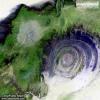-
Posts
440 -
Joined
-
Days Won
15
Content Type
Profiles
Forums
Events
Blogs
Gallery
Posts posted by Henry
-
-
THE RESTAURANT' !
Anyone want a free meal at a restaurant with a view????
First - take the tram up to the start of the trail.

Now follow the path!

Be sure to hold on to the 'railing'!!

Keep an eye on the person in front of you!

Be very careful when passing someone going in the opposite direction

Now just up a few steps. (they are on the left in the picture).

Gets a little steeper here - so put your toes in the holes

A few more steps to go .

Finally in sight.

This restaurant is in China
If you manage to reach the restaurant the food is free

-
Happy Birthday Napalm

-
If anyone tried to make flood in your private This command to Lock in private message to protect against flooding
-----------------------------------------------------------------------------
on *:TEXT:*:?:{
inc %priv-floodd. [ $+ [ $nick ] ] | .timer 1 3 unset %priv-floodd. [ $+ [ $nick ] ]
if (%priv-floodd. [ $+ [ $nick ] ] >= 30) {
.ignore -u30 $wildsite
close -m $nick
msg $nick HeHeHeHe Try To Flood Me Again Baby
/echo $nick ,ignore 30 Secs. and Closed Msg | halt }
}
-----------------------------------------------
-
Happy Birthday, David

-
Happy Birthday, gh

-

Mummification one advances in the ancient Egyptian civilization and indicates the extent to which his own language in understanding the secrets of many of the mysteries of the world and on the correct amount of ammunition you got from a scientific knowledge of accurate and correct
The ancient Egyptians believed in life after death. The ancient Egyptian religions say that man can not be resurrected in the Hereafter only after returning the soul to the body.
I think it should be the pharaohs embalmed the dead to protect the body from decomposition to be able to find the soul from the body to be a process of resurrection.
Have developed methods of embalming the Pharaohs over hundreds of years and discovered that it must first remove the internal organs to protect the body from decomposition, and then treated with salts, glues, oil, rice, honey, tar and dried in order to protect them from germs.
The researchers report they published in the science journal Nature that the choice of the components of embalming materials was influenced by the cost factor and the shouts of the fashion that prevailed.
It was a wealthy ancient Egyptians are keen to buy embalming materials precious to honor their dead, as some of the wealthy resort today to buy coffins and precious luxury building tombs.
That the secret of mummification remains always more mysteries of the Pharaohs mysterious and exciting
-
Happy Birthday Patsy

 Patsy
Patsy -
AIDS (acquired immune deficiency syndrome) is the final stage of
HIV disease, which causes severe damage to the immune system.Causes, incidence, and risk factors
Important facts about the spread of AIDS include:
-
AIDS is the sixth leading cause of death among people ages 25 - 44 in the United States, down from number one in 1995. -
The World Health Organization estimates that more than 25 million people worldwide have died from this infection since the start of the epidemic. -
In 2008, there were approximately 33.4 million people around the world living with HIV/AIDS, including 2.1 million children under age 15.
Human immunodeficiency virus (HIV) causes AIDS. The virus attacks the immune system and leaves the body vulnerable to a variety of life-threatening infections and cancers.
Common bacteria, yeast, parasites, and viruses that usually do not cause serious disease in people with healthy immune systems can cause fatal illnesses in people with AIDS.
HIV has been found in saliva, tears, nervous system tissue and spinal fluid, blood, semen (including pre-seminal fluid, which is the liquid that comes out before ejaculation), vaginal fluid, and breast milk. However, only blood, semen, vaginal secretions, and breast milk have been shown to transmit infection to others.
The virus can be spread (transmitted):
-
Through sexual contact -- including oral, vaginal, and anal sex -
Through blood -- via blood transfusions (now extremely rare in the U.S.) or needle sharing -
From mother to child -- a pregnant woman can transmit the virus to her fetus through their shared blood circulation, or a nursing mother can transmit it to her baby in her breast milk
Other methods of spreading the virus are rare and include accidental needle injury, artificial insemination with infected donated semen, and organ transplantation with infected organs.
HIV infection is NOT spread by:
-
Casual contact such as hugging -
Mosquitoes -
Participation in sports -
Touching items that were touched by a person infected with the virus
AIDS and blood or organ donation:
-
AIDS is NOT transmitted to a person who DONATES blood or organs. People who donate organs are never in direct contact with people who receive them. Likewise, a person who donates blood is never in contact with the person receiving it. In all these procedures, sterile needles and instruments are used. -
However, HIV can be transmitted to a person RECEIVING blood or organs from an infected donor. To reduce this risk, blood banks and organ donor programs screen donors, blood, and tissues thoroughly.
People at highest risk for getting HIV include:
-
Injection drug users who share needles -
Infants born to mothers with HIV who didn't receive HIV therapy during pregnancy -
People engaging in unprotected sex, especially with people who have other high-risk behaviors, are HIV-positive, or have AIDS -
People who received blood transfusions or clotting products between 1977 and 1985 (before screening for the virus became standard practice) -
Sexual partners of those who participate in high-risk activities (such as injection drug use or anal sex)
Symptoms
AIDS begins with HIV infection. People who are infected with HIV may have no symptoms for 10 years or longer, but they can still transmit the infection to others during this symptom-free period. If the infection is not detected and treated, the immune system gradually weakens and AIDS develops.
Acute HIV infection progresses over time (usually a few weeks to months) to asymptomatic HIV infection (no symptoms) and then to early symptomatic HIV infection. Later, it progresses to AIDS (advanced HIV infection with CD4 T-cell count below 200 cells/mm3 ).
Almost all people infected with HIV, if they are not treated, will develop AIDS. There is a small group of patients who develop AIDS very slowly, or never at all. These patients are called nonprogressors, and many seem to have a genetic difference that prevents the virus from significantly damaging their immune system.
The symptoms of AIDS are mainly the result of infections that do not normally develop in people with a healthy immune system. These are called opportunistic infections.
People with AIDS have had their immune system damaged by HIV and are very susceptible to these opportunistic infections. Common symptoms are:
-
Chills -
Fever -
Sweats (particularly at night) -
Swollen lymph glands -
Weakness -
Weight loss
Note: At first, infection with HIV may produce no symptoms. Some people, however, do experience flu-like symptoms with fever, rash, sore throat, and swollen lymph nodes, usually 2 - 4 weeks after contracting the virus. Some people with HIV infection stay symptom-free for years between the time when they are exposed to the virus and when they develop AIDS.
Signs and tests
CD4 cells are a type of T cell. T cells are cells of the immune system. They are also called "helper cells."
The following is a list of AIDS-related infections and cancers that people with AIDS may get as their CD4 count decreases. In the past, having AIDS was defined as having HIV infection and getting one of these other diseases. Today, according to the Centers for Disease Control and Prevention, a person may also be diagnosed with AIDS if they are HIV-positive and have a CD4 cell count below 200 cells/mm3, even if they don't have an opportunistic infection.
AIDS may also be diagnosed if a person develops one of the opportunistic infections and cancers that occur more commonly in people with HIV infection. These infections are unusual in people with a healthy immune system.
Many other illnesses and their symptoms may develop, in addition to those listed here.
The following illnesses are common with a CD4 count below 350 cells/mm3:
-
Herpes simplex virus -- causes ulcers/small blisters in the mouth or genitals, happens more often and usually much more severely in an HIV-infected person than in someone without HIV infection -
Herpes zoster (shingles) -- ulcers/small blisters over a patch of skin, caused by reactivation of the varicella zoster virus, the same virus that causes chickenpox -
Kaposi's sarcoma -- cancer of the skin, lungs, and bowel due to a herpes virus (HHV-8). It can happen at any CD4 count, but is more likely to happen at lower CD4 counts, and is more common in men than in women. -
Non-Hodgkin's lymphoma -- cancer of the lymph nodes -
Oral or vaginal thrush -- yeast (typically Candida albicans) infection of the mouth or ****** -
Tuberculosis -- infection by tuberculosis bacteria mostly affects the lungs, but can also affect other organs such as the bowel, lining of the heart or lungs, brain, or lining of the central nervous system (brain and spinal cord)
Common with CD4 count below 200 cells/mm3:
-
Bacillary angiomatosis -- skin sores caused by a bacteria called Bartonella, which may be caused by cat scratches -
Candida esophagitis -- painful yeast infection of the esophagus -
Pneumocystis jiroveci pneumonia, "PCP pneumonia," previously called Pneumocystis cariniipneumonia, caused by a fungus
Common with CD4 count below 100 cells/mm3:
-
AIDS dementia -- worsening and slowing of mental function, caused by HIV -
Cryptococcal meningitis -- fungal infection of the lining of the brain -
Cryptosporidium diarrhea -- Extreme diarrhea caused by a parasite that affects the gastrointestinal tract -
Progressive multifocal leukoencephalopathy -- a disease of the brain caused by a virus (called the JC virus) that results in a severe decline in mental and physical functions -
Toxoplasma encephalitis -- infection of the brain by a parasite, called Toxoplasma gondii, which is often found in cat feces; causes lesions (sores) in the brain -
Wasting syndrome -- extreme weight loss and loss of appetite, caused by HIV itself
Common with CD4 count below 50/mm3:
-
Cytomegalovirus infection -- a viral infection that can affect almost any organ system, especially the large bowel and the eyes -
Mycobacterium avium -- a blood infection by a bacterium related to tuberculosis
In addition to the CD4 count, a test called HIV RNA level (or viral load) may be used to monitor patients. Basic screening lab tests and regular cervical Pap smears are important to monitor in HIV infection, due to the increased risk of cervical cancer in women with a compromised immune system. Anal Pap smears to detect potential cancers may also be important in both HIV-infected men and women.
Treatment
There is no cure for AIDS at this time. However, a variety of treatments are available that can help keep symptoms at bay and improve the quality of life for those who have already developed symptoms.
Antiretroviral therapy suppresses the replication of the HIV virus in the body. A combination of several antiretroviral drugs, called highly active antiretroviral therapy (HAART), has been very effective in reducing the number of HIV particles in the bloodstream. This is measured by the viral load (how much free virus is found in the blood). Preventing the virus from replicating can improve T-cell counts and help the immune system recover from the HIV infection.
HAART is not a cure for HIV, but it has been very effective for the past 12 years. People on HAART with suppressed levels of HIV can still transmit the virus to others through sex or by sharing needles. There is good evidence that if the levels of HIV remain suppressed and the CD4 count remains high (above 200 cells/mm3), life can be significantly prolonged and improved.
However, HIV may become resistant to one combination of HAART, especially in patients who do not take their medications on schedule every day. Genetic tests are now available to determine whether an HIV strain is resistant to a particular drug. This information may be useful in determining the best drug combination for each person, and adjusting the drug regimen if it starts to fail. These tests should be performed any time a treatment strategy begins to fail, and before starting therapy.
When HIV becomes resistant to HAART, other drug combinations must be used to try to suppress the resistant strain of HIV. There are a variety of new drugs on the market for treating drug-resistant HIV.
Treatment with HAART has complications. HAART is a collection of different medications, each with its own side effects. Some common side effects are:
-
Collection of fat on the back ("buffalo hump") and abdomen -
General sick feeling (malaise) -
Headache -
Nausea -
Weakness
When used for a long time, these medications increase the risk of heart attack, perhaps by increasing the levels of cholesterol and glucose (sugar) in the blood.
Any doctor prescribing HAART should carefully watch the patient for possible side effects. In addition, blood tests measuring CD4 counts and HIV viral load should be taken every 3 months. The goal is to get the CD4 count as close to normal as possible, and to suppress the amount of HIV virus in the blood to a level where it cannot be detected.
Other antiviral medications are being investigated. In addition, growth factors that stimulate cell growth, such as erthythropoetin (Epogen, Procrit, and Recomon) and filgrastim (G-CSF or Neupogen) are sometimes used to treat AIDS-associated anemia and low white blood cell counts.
Medications are also used to prevent opportunistic infections (such as Pneumocystis jiroveci pneumonia) if the CD4 count is low enough. This keeps AIDS patients healthier for longer periods of time. Opportunistic infections are treated when they happen.
Support Groups
Joining support groups where members share common experiences and problems can often help the emotional stress of devastating illnesses. See AIDS - support group.
Expectations (prognosis)
Right now, there is no cure for AIDS. It is always fatal without treatment. In the U.S., most patients survive many years after diagnosis because of the availability of HAART. HAART has dramatically increased the amount of time people with HIV remain alive.
Research on drug treatments and vaccine development continues. However, HIV medications are not always available in the developing world, where most of the epidemic is raging.
Complications
When a person is infected with HIV, the virus slowly begins to destroy that person's immune system. How fast this occurs differs in each individual. Treatment with HAART can help slow or halt the destruction of the immune system.
Once the immune system is severely damaged, that person has AIDS, and is now susceptible to infections and cancers that most healthy adults would not get. However, antiretroviral treatment can still be very effective, even at that stage of illness.
Calling your health care provider
Call for an appointment with your health care provider if you have any of the risk factors for HIV infection, or if you develop symptoms of AIDS. By law, the results of HIV testing must be kept confidential. Your health care provider will review results of your testing with you.
Prevention
-
See the article on safe sex to learn how to reduce the chance of catching or spreading HIV, and other sexually transmitted diseases. -
Do not use illicit drugs and do not share needles or syringes. Many communities now have needle exchange programs, where you can get rid of used syringes and get new, sterile ones. These programs can also provide referrals for addiction treatment. -
Avoid contact with another person's blood. You may need to wear protective clothing, masks, and goggles when caring for people who are injured. -
Anyone who tests positive for HIV can pass the disease to others and should not donate blood, plasma, body organs, or sperm. Infected people should tell any sexual partner about their HIV-positive status. They should not exchange body fluids during sexual activity, and should use preventive measures (such as condoms) to reduce the rate of transmission. -
HIV-positive women who wish to become pregnant should seek counseling about the risk to their unborn child, and methods to help prevent their baby from becoming infected. The use of certain medications dramatically reduces the chances that the baby will become infected during pregnancy. -
The Public Health Service recommends that HIV-infected women in the United States avoid breast-feeding to prevent transmitting HIV to their infants through breast milk. -
Safer sex practices, such as latex condoms, are highly effective in preventing HIV transmission. HOWEVER, there is a risk of acquiring the infection even with the use of condoms. Abstinence is the only sure way to prevent sexual transmission of HIV.
The riskiest sexual behavior is receiving unprotected anal intercourse. The least risky sexual behavior is receiving oral sex. There is some risk of HIV transmission when performing oral sex on a man, but this is less risky than unprotected vaginal intercourse. Female-to-male transmission of the virus is much less likely than male-to-female transmission. Performing oral sex on a woman who does not have her period has a low risk of transmission.
HIV-positive patients who are taking antiretroviral medications are less likely to transmit the virus. For example, pregnant women who are on effective treatment at the time of delivery, and who have undetectable viral loads, give HIV to their baby less than 1% of the time, compared with 13% to 40% of the time if medications are not used.
The U.S. blood supply is among the safest in the world. Nearly all people infected with HIV through blood transfusions received those transfusions before 1985, the year HIV testing began for all donated blood.
If you believe you have been exposed to HIV, seek medical attention IMMEDIATELY. There is some evidence that an immediate course of antiviral drugs can reduce the chances that you will be infected. This is called post-exposure prophylaxis (PEP), and it has been used to prevent transmission in health care workers injured by needlesticks.
There is less information available about how effective PEP is for people exposed to HIV through sexual activity or injection drug use, but it appears to be effective. If you believe you have been exposed, discuss the possibility with a knowledgeable specialist (check local AIDS organizations for the latest information) as soon as possible. Anyone who has been sexually assaulted should consider the potential risks and benefits of PEP.
References
-
Del Rio C, Curran JW. Epidemiology and prevention of acquired immunodeficiency syndrome and human immunodeficiency virus infection. In: Mandell GL, Bennett JE, Dolin R, eds. Principles and Practice of Infectious Diseases. 7th ed. Philadelphia, Pa: Elsevier Churchill Livingstone; 2009:chap 118.
-
Piot P. Human immunodeficiency virus infection and acquired immunodeficiency syndrome: A global overview. In: Goldman L, Ausiello D, eds. Cecil Medicine. 23rd ed. Philadlelphia, Pa: Saunders Elsevier; 2007:chap 407.
-
Sterling TR, Chaisson RE. General clinical manifestations of human immunodeficiency virus infection (including the acute retroviral syndrome and oral, cutaneous, renal, ocular, metabolic, and cardiac diseases). In: Mandell GL, Bennett JE, Dolin R, eds. Principles and Practice of Infectious Diseases. 7th ed. Philadelphia, Pa: Elsevier Churchill Livingstone; 2009:chap 121.
-
-
Happy Birthday, NamelessMe!


-
Very nice koach
-
These trees there would devour anything in the way of growth, regardless
Of the size of this thing. They grow over and through many
Of things just to contact for these things. Such as fences,
Bicycles, cars, traffic lights and other objects of similar
Which can be found on the sidewalks near these trees.
Most of these photos taken in America, and some other places
Different in the world, including the huge tree that swallowed up the British Fund
Mail to the Central London close to the trunk.
In order to reach the stage of engorgement full of things, these trees
Eat it slowly makes the process of engorgement takes nearly thirty years.





-
This is a picture of the bathroom floor
In the house of painter resident in the thirtieth floor
Imagine you are invited to dinner with him
And opened the bathroom door and entered
What will happen to you?


-
Can you imagine that there is a living being with us live on this earth, He came to the point that evolution does not reach the stage of aging and therefore can not die (naturally)?!!
The idea may seem suitable for a legendary science fiction movies, but we are talking about a real object, scientists discovered that it does not die, and his name Turritopsis nutricula

Surprisingly, this object is a species of jellyfish, and discovered a group of biologists at the University of Lecce Italian that he was able to regenerate body cells are constantly, and therefore does not reach the stage of old age never

Where it passes any jellyfish stages of growth:
- The stage of immaturity or the so-called phase Alpolb, when the jellyfish creature very simple.
- Adulthood or maturity, while this lamp can multiply and produce other sea jellyfish.
And natural is to pass any jellyfish stage immaturity and maturity, and death, but EFCT can go through that stage the contrary!
The sense that it just be up to the stage of puberty can return to the stage of immaturity again, and then mature and immaturity, and so on .., so you do not reach the stage of old age and therefore do not ever die (naturally)!

The reason for this surprising ability is a biological process called Transdifferentiation, means the ability of the organism to regenerate body cells grow, such as salamanders, while his body parts cut again, but Ka
-
Famine in Africa
Eagle awaiting the death of this child to eat him

This child who pulls his mother and thought to be dormant and wants to awaken
And did not know that his mother had died of hunger and thirst

I am Sorry for the dissemination of these images sad

-
To watch together a list of ten strangest places on earth
1-Socotra Island - Yemen
It contains wonderful this island more than 700 species of animals and rare plants
2-Salar de Uni - Bolivian
If you go to this fascinating place, you will feel like you are dreaming, because this place has the largest salt desert in the world! What makes it fascinating and there is a thin layer of water above the salt
3 - Klylock Lake - Canada
4 - Dry valleys - Antarctica
5 - Rio Tinto, Spain
And the name of the region is taken from the name of the river Rio Tinto, which is characterized by red color, because the high water acidity and rich in minerals.
6 - The hot spring pool of blood - Japan
Looks as if it were a scene from a horror film that dominated the vampire world, but hot water pond located in Japan, and gained a strange red color concentration of iron in its waters.
7 - Configure quills - Mauritania
Is one of the wonders of nature that scientists could not find out the cause of their formation until now, the composition of very large diameter of up to 30 miles to the point where it is hard to see him only from space.
8 - Vale de Lua - Brazil
Means the Valley of the Moon, which is formed by the formations Ckarh water, are found in a forest, Brazil Cerrado, and consists of quartz stones, which is one of the oldest known rock formations on earth.
9 - Stone Forest - China
Which means Forest Shilin Stone Forest in Chinese, is a geological wonderland which is composed of limestone, which Nanth water through different geological ages, to produce this wonderful masterpiece.
10 - Oasriceoilt ice cave - Austria
Different caves ice caves for the ordinary in that it gives you the impression that makes you feel like you came out of the planet and has become the planet Pluto, for example.
There are many ice caves in the world, but this cave is the largest, which extends for a distance of 40 kilometers.
-
Happy Birthday, KaRiM

-
Happy Birthday, Casa

-
-
What are the kidneys?
The kidneys play key roles in body function, not only by filtering the blood and getting rid of waste products, but also by balancing levels of electrolytes in the body, controlling blood pressure, and stimulating the production of red blood cells.
The kidneys are located in the abdomen toward the back, normally one of each side of the spine. They get their blood supply through the renal arteries directly from the aorta and send blood back to the heart via the renal veins to the vena cava. (The term "renal" is derived from the Latin name for kidney).
The kidneys have the ability to monitor the amount of body fluid, the concentrations of electrolytes like sodium and potassium, and the acid-base balance of the body. They filter waste products of body metabolism, like urea from protein metabolism and uric acid from DNA breakdown. Two waste products in the blood can be measured: blood urea nitrogen (BUN) and creatinine (Cr).
When blood flows to the kidney, sensors within the kidney decide how much water to excrete as urine, along with what concentration of electrolytes. For example, if a person is dehydrated from exercise or from an illness, the kidneys will hold onto as much water as possible and the urine becomes very concentrated. When adequate water is present in the body, the urine is much more dilute, and the urine becomes clear. This system is controlled by renin, a hormone produced in the kidney that is part of the fluid and blood pressure regulation systems of the body.
Kidneys are also the source of erythropoietin in the body, a hormone that stimulates the bone marrow to make red blood cells. Special cells in the kidney monitor the oxygen concentration in blood. If oxygen levels fall, erythropoietin levels rise and the body starts to manufacture more red blood cells.
After the kidneys filter blood, the urine is excreted through the ureter, a thin tube that connects it to the bladder. It is then stored in the bladder awaiting urination, when the bladder sends the urine out of the body through the urethra.
What causes kidney failure?
Kidney failure can occur from an acute situation or from chronic problems.
In acute renal failure, kidney function is lost rapidly and can occur from a variety of insults to the body. The list of causes is often categorized based on where the injury has occurred.
Prerenal causes causes are due to decreased blood supply to the kidney.
Examples of prerenal causes are:
-
Drug Interactions
Drug-drug interactions occur when two or more drugs react with each other. This drug-drug interaction may cause you to experience an unexpected side effect. For example, mixing a drug you take to help you sleep (a sedative) and a drug you take for allergies (an antihistamine) can slow your reactions and make driving a car or operating machinery dangerous.
Drug-food/beverage interactions result from drugs reacting with foods or beverages. For example, mixing alcohol with some drugs may cause you to feel tired or slow your reactions.
Drug-condition interactions may occur when an existing medical condition makes certain drugs potentially harmful. For example, if you have high blood pressure you could experience an unwanted reaction if you take a nasal decongestant.
A drug interaction is a situation in which a substance affects the activity of a drug, i.e. the effects are increased or decreased, or they produce a new effect that neither produces on its own. Typically, interaction between drugs come to mind (drug-drug interaction). However, interactions may also exist between drugs & foods (drug-food interactions), as well as drugs & herbs (drug-herb interactions).
Generally speaking, drug interactions are to be avoided, due to the possibility of poor or unexpected outcomes. However, drug interactions have been deliberately used, such as co-administering probenecid with penicillin prior to mass production of penicillin. Because penicillin was difficult to manufacture, it was worthwhile to find a way to reduce the amount required. Probenecid retards the excretion of penicillin, so a dose of penicillin persists longer when taken with it, and it allowed patients to take less penicillin over a course of therapy.
A contemporary example of a drug interaction used as an advantage is the co-administration of carbidopa with levodopa (available as Carbidopa/levodopa). Levodopa is used in the management of Parkinson's disease and must reach the brain in an un-metabolized state to be beneficial. When given by itself, levodopa is metabolized in the peripheral tissues outside the brain, which decreases the effectiveness of the drug and increases the risk of adverse effects. However, since carbidopa inhibits the peripheral metabolism of levodopa, the co-administration of carbidopa with levodopa allows more levodopa to reach the brain un-metabolized and also reduces the risk of side effects.
Drug interactions may be the result of various processes. These processes may include alterations in the pharmacokinetics of the drug, such as alterations in the Absorption, Distribution, Metabolism, and Excretion (ADME) of a drug. Alternatively, drug interactions may be the result of the pharmacodynamic properties of the drug, e.g. the co-administration of a receptor antagonist and an agonist for the same receptor.
Metabolic drug interactions:
Many drug interactions are due to alterations in drug metabolism.[1] Further, human drug-metabolizing enzymes are typically activated through engagement of nuclear receptors.[1]
One notable system involved in metabolic drug interactions is the enzyme system comprising the cytochrome P450 oxidases. This system may be affected by either enzyme induction or enzyme inhibition, as discussed in the examples below.
Enzyme induction - drug A induces the body to produce more of an enzyme which metabolises drug B. This reduces the effective concentration of drug B, which may lead to loss of effectiveness of drug B. Drug A effectiveness is not altered.
Enzyme inhibition - drug A inhibits the production of the enzyme metabolising drug B, thus an elevation of drug B occurs possibly leading to an overdose.
Bioavailability - drug A influences the absorption of drug B.
The examples described above may have different outcomes depending on the nature of the drugs. For example, if Drug B is a prodrug, then enzyme activation is required for the drug to reach its active form. Hence, enzyme induction by Drug A would increase the effectiveness of the drug B by increasing its metabolism to its active form. Enzyme inhibition by Drug A would decrease the effectiveness of Drug B.
This is the first article in a series of three that discuss various aspects of drug interactions. This article provides a general overview of the types of drug interactions. The second and third articles will focus on pharmacokinetic and pharmacodynamic drug interactions and drug interactions involving the cytochrome P450 metabolic enzyme pathway, respectively. To assist the pharmacist in applying this information in practice, a patient case study will be included with each article. The case study will illustrate one or more drug interactions and examples of care plans that address specific drug interaction problems.
Over the past two years, approximately 80 new prescription drug products have been introduced in the United States. With increasing frequency, pharmacists are being questioned by their patients whether a new prescription drug will interact with any of their routine medications. Unfortunately, each year a number of deaths occur as the direct result of patients taking a new prescription drug in combination with their existing medication regimen. A small number of drugs are withdrawn from the market annually because patients experience harmful adverse drug reactions (ADRs) or drug interactions. Although many ADRs are detected during clinical drug trials, the side effect profiles of a new drug often require more extensive use
-
Young Love
Love is patient, love is kind,
And what our loves express is true.
No amount of tragedy can tear
Or break the love I have for you.
Time has healed our many wounds,
But has not erased the memory.
But we'll hold on, we'll stay together.
We will get through this, you and me.
Though we are young and still learning
About ourselves, our world today,
In my heart, I'll always love you,
And in my heart you'll always stay.
As days go by, as time progresses,
We will change, mature, and always grow.
But as we grow, as we reminisce,
There is one thing I will always know.
My love for you will never falter,
Never cease, for it's always true.
With love comes patience, but it's worth the wait,
To share my unending love with you.
--Jessica Wheaton--
-
Happy Birthday Stormy

-
Happy Birthday neon

-
ISLAM IS NOT THE SOURCE OF TERRORISM
As Muslims, we strongly condemn the terrorist attack on the two big cities of the United States of America on September 11, 2001 that caused the death and injury
of thousands of innocent people, and offer our condolences to the American people. These attacks carried a very important issue related to the true source of terrorism to the top of the world agenda. By this occasion, it was announced to the entire world that Islam is a religion of peace and tolerance and that it summons people to compassion and justice.
Many world leaders, leading media organizations, television and radio stations told their own people that true Islam forbids violence, and commands peace between people and nations. The Western circles that have come to a full grasp of the religion of Islam and are well-informed about the true Islam commanded by God in the Koran noted clearly that the words of Islam and terror cannot stand side by side, and divine religions by no means permit violence.
This essay maintains that the source of the terror that we condemn is definitely not a divine religion, and that there is no room for terrorism in Islam. This is made clear in the Koran, the main source of Islam, and in the practices of all Muslim rulers, the Prophet Muhammad, peace be upon him, being the foremost of them.
As you know, for centuries, various acts of terrorism are being carried out in different parts of the world by different groups for different purposes. Sometimes a communist organization, sometimes a fascist group, and sometimes radical and separatist factions assume responsibility for these acts. While countries like America often become the target of the attacks of racist and marginal terrorist groups, the European countries become the center stage for violent acts carried out by terrorist groups. 17 November in Greece, RAF and Neo-Nazis in Germany, ETA in Spain, Red Brigades in Italy and many other organizations seek to make their voices heard through terror and violence by killing innocent and defenseless people heinously. Terrorism changes with the developing and changing world conditions and steps up its impact and power with the new means made possible by the developing technology. In particular, mass communication tools such as the Internet extends the
scope and influence of the terrorist activities considerably.
Besides USA and Europe originated Western organizations, there are also other terror organizations of Middle East origin. Some terrorist attacks are carried out by these groups in all corners of the world. Yet there is an important point to be remembered here. The fact that the perpetrators of various terrorist acts carry Christian, Muslim or Jewish identities cause some people to develop some erroneous ideas and put forward some claims which do not concur with divine religions. The fact remains however, that even if the terrorists have Muslim identities, the terror they perpetrated cannot be labeled "Islamic terror". In the same way, it would not be called "Jewish terror" if the perpetrators were Jews or "Christian terror" if they were Christians. That is because, murdering innocent people in the name of religion is unacceptable. We need to keep in mind that, among those who were killed in Washington or New York, there were people who loved Jesus (Christians), Prophet Moses (Jews) and Muslims. Unless forgiven by God, murdering innocent people is a great sin that brings torment in Hell. Thus, a religious person who has fear of God can never commit such an act.
The aggressors can commit such violence only with the intention of attacking religion itself. It may well be that they carried out this violence to present religion as evil in the eyes of people, to divorce people from religion and to generate hatred and reaction against pious people. Consequently, every attack made in the name of "religion" on innocent people is actually an attack made against religion.
Religion commands love, mercy and peace. Terror, on the other hand, is the opposite of religion; it is cruel, merciless and it demands bloodshed and misery. This being the case, while looking for the perpetrators of a terrorist act, its origins should be sought in disbelief rather than in religion. People with a fascist, communist, racist or materialist outlook on life should be suspected as potential perpetrators. The name or the identity of the terrorists is not important. If he can kill innocent people without blinking an eye, then he is a disbeliever, not a believer. He is a murderer with no fear of God, whose main ambition is to shed blood and to give harm. For this reason, "Islamic terror", "Jewish terror", "Christian terror" are quite erroneous concepts. That is because, neither the religion of Islam, nor other religions can by no means concur with terror. On the contrary, "terror" (i.e. murders committed against innocent people) in Islam is a great sin and Muslims are responsible for preventing these acts and bringing peace and justice to the world.
http://www.religious...g/turker_01.htm
The full-text of this article is available on
http://www.islamdenouncesterrorism.com/
----------------------------------------------------------
and I apologize to all administration if this kind of subjects did not allow in the forum















Interesting Facts !!
in General Discussion
Posted
A goldfish is the only animal that can see both infrared and ultraviolet light
* * * * * * * *
The human eye blinks an average of 4,200,000 times a year
* * * * * * * *
The world's largest amphibian is the giant salamander. It can grow up to 5 ft. in length
* * * * * * * *
On average women say 7,000 words per day. Men manage just over 2,000
* * * * * * * *
The temperature at the centre of the Earth is estimated to be 5500 degrees Celsius
* * * * * * * *
The longest living cells in the body are brain cells which can live an entire lifetime
* * * * * * * *
The only letter not appearing on the Periodic Table is the letter J
* * * * * * * *
According to an old English system of time units, a moment is one and a half minutes
* * * * * * * *
Hummingbirds are the only birds able to fly backwards
I hope you enjoyed reading these interesting facts